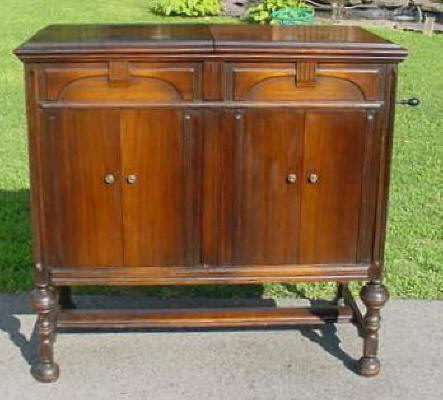
The Victor-Victrola Page
 VV
7-3 / VE 7-3 X
VV
7-3 / VE 7-3 X
RARITY: ¤¤ VALUE: ¤

 The
VV 7-3 was a popular early "home entertainment center" pairing a Victor
Orthophonic (acoustic) phonograph with an RCA Radiola 20, which was at the time
was their best "TRF" (Tuned Radio Frequency) set. The TRF was a significant
advance in home radio designs, and provided exceptional performance without the
need to adjust multiple dials to tune-in a radio station. The phonograph featured a
two-spring motor and a small "folded" horn. As was the case with many radio
sets of that timeframe, the radio was
powered by a group of batteries that were mounted inside the cabinet. A large
mechanical-valve "switch" would change the routing from the radio's
electromagnetic driver or from the phonograph's tonearm directly to the horn's
"neck". It was truly an exceptional performer when launched, but rapidly
advancing technology quickly overtook this design. Since the newly-developed
paper-cone speaker, which provided better sound (and eliminated the large
mechanical switching valve) was beginning to become popular the following year,
the 7-3 became obsolete shortly after it was introduced.
The
VV 7-3 was a popular early "home entertainment center" pairing a Victor
Orthophonic (acoustic) phonograph with an RCA Radiola 20, which was at the time
was their best "TRF" (Tuned Radio Frequency) set. The TRF was a significant
advance in home radio designs, and provided exceptional performance without the
need to adjust multiple dials to tune-in a radio station. The phonograph featured a
two-spring motor and a small "folded" horn. As was the case with many radio
sets of that timeframe, the radio was
powered by a group of batteries that were mounted inside the cabinet. A large
mechanical-valve "switch" would change the routing from the radio's
electromagnetic driver or from the phonograph's tonearm directly to the horn's
"neck". It was truly an exceptional performer when launched, but rapidly
advancing technology quickly overtook this design. Since the newly-developed
paper-cone speaker, which provided better sound (and eliminated the large
mechanical switching valve) was beginning to become popular the following year,
the 7-3 became obsolete shortly after it was introduced.
This Victrola could be ordered with either a spring powered phonograph (VV
7-3)
or with an electric motor option (VE 7-3). To clarify this
confusing terminology, the electric-motor designation refers to the phonograph
motor only; in both models the radio was battery powered. VE versions eliminated
the need to hand-wind the phonograph motor.
The 7-3 was introduced in the summer of 1926, and production ran for a few
months and was discontinued when more
advanced (and lower cost) radio/phono systems became available on the market. It sold new for $375.00, which equates
to approximately $5,500.00 in today's money. The electric motor was a $35.00
option.
Approximately 9,000 VV 7-3 consoles were produced in
the second half of 1926, and 4,000 electric motor (VE 7-3) versions
were made. Since radio and electronic technology was developing so rapidly
in the mid-1920's, the 7-3 became outdated very quickly, and many were sold at
discount the following year.
The high cost of restoration of these early electronic sets
limits the interest of many collectors today.
The current survival database shows the earliest existent VV 7-3 to be s/n 555 and the latest to be s/n 7482
The earliest existent VV 7-3 to be s/n 701 and the latest to be s/n 3332
Do you own a Victrola 7-3? Please take a moment and enter some basic information about your machine into the collector's database by clicking here. No personal information is required.